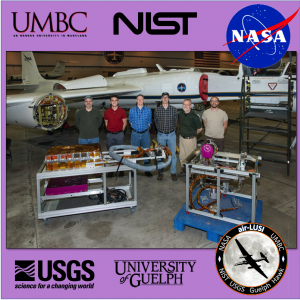Airborne Lunar Spectral Irradiance (Air-LUSI)
Status
Instrument System: Air-LUSI IRIS instrument enclosure (top of cart on the left with gold foil), ARTEMIS control system assemble (purple box, bottom left), the IRIS telescope (on cart on the right), and the ARTEMIS robotic mount (beneath the telescope). Air-LUSI field team (from left to right): Dr. Steven Grantham (NIST), Mr. Andrew Newton (University of Guelph), Dr. Kevin Turpie (PI, UMBC), Dr. John Woodward (NIST), Mr. Thomas Larason (NIST), and Dr. Stephen Maxwell (NIST). Not shown: Dr. Steven Brown (NIST), Dr. Andrew Gadsden (University of Guelph), and Dr. Thomas Stone (USGS).
A. First-look measurements of lunar spectral irradiance on five consecutive nights, 13-17 (UTC) Nov 2019. These correspond to lunar phases of 10°, 21°, 34°, 46° and 59°.
B. Uncertainty budget for the Air-LUSI demonstration flights. Demonstration accuracy estimated to be ~0.8% (k=1) from 450 nm to 950 nm. <0.5% (k=1) is expected for operational flights.
Air-LUSI makes highly-accurate, SI-traceable measurements of lunar spectral irradiance. These measurements can be used to validate or adjust current models of lunar spectral irradiance used for calibration Earth observing satellites. Air-LUSI is initially being used to address the current 5-10% uncertainty in knowledge of exo-atmospheric spectral lunar irradiance. Improved lunar spectral irradiance model accuracy will help satellite instruments to use the Moon as an absolute calibration reference, greatly improving the versitility and speed of on-orbit satellite calibration. Air-LUSI has two main subsystems:
- IRIS - IRradiance Instrument Subsystem is a non-imaging telescope with an integrating sphere feeding light via fiber optics to a spectrometer.
- ARTEMIS - Autonomous, Robotic TElescope Mount Instrument Subsystem keeps telescope fixed on the Moon to within less than 0.1°. This system uses a tracking camera on the telescope and control computer.
We are targeting lunar phases withing 5° to 90° of the Full Moon. Air-LUSI measurements lunar spectral irradiance with spectral resolution of 3.7 nm with 0.8 nm sampling from 300 nm to 1100 nm, with accuracy target of better than 1% (k=1). Future system performance will include measurements out to 2500 nm with ≤ 10 nm resolution. Demonstration flights with the Air-LUSI provided an unprecedented sub-percent level of accuracy <0.8% (k=1) relative uncertainty from 400 nm to 950 nm. Future measurement accuracy is expected to be <0.5% (k=1).


